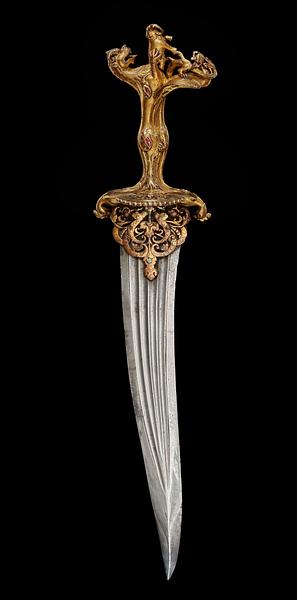Sultan Ali Adil Shah of Bijapur (1558-1579) was depicted several times in
contemporary miniatures with a dagger similar to this one.
The zoomorphic hilt was clearly influenced by Hindu art, and it is in fact possible that the dagger was booty taken from Vijayanagar, which the united Deccan sultans conquered in the battle at Talikota in 1565.
In an elegant, flowing style, one side of the hilt is made up of quite a large lion holding a little elephant between its front paws, while a phoenix and a dragon with a long tail are engaged in a battle of life and death on the other side.
The guard consists of two phoenixes whose heads are turned toward the steel blade.
Inv. no. 36/1997
Published in:
Christie's, London, 23/4-1994, lot 131;
George Michell and Mark Zebrowski: Architecture and art of the Deccan Sultanates, Cambridge 1999, fig. 169, p. 231;
Kjeld von Folsach: Art from the World of Islam in The David Collection, Copenhagen 2001, cat.no. 568;
Robert Elgood: Hindu arms and ritual: arms and armour from India 1400-1865, Delft 2004, pp. 114 and 115, fig. 11.7;
Sheila S. Blair and Jonathan M. Bloom (eds.): Cosmophilia. Islamic Art from the David Collection, Copenhagen, McMullen Museum of Art, Boston College, Boston 2006, cat.no. 21;
Gian Carlo Calza (ed.): Akbar : the Great Emperor of India 1542-1605, Fondazione Roma Museo, Milano 2012, cat.no. IV.19, pp. 166-167 and 259;
Howard Ricketts: “Ahmadnagar: Nizan Shahi blazons, animal sculptures and zoomorphic arms in the 16th century” in Journal of the David Collection, 4, 2014, p. 158, fig. 17;
Daniel C. Waugh: "The David Collection: Journal of the David Collection. 4" in The Silk road, 2014, 12, Featured museum, I: fig. 4;
Navina Najat Haidar and Marika Sardar: Sultans of Deccan India, 1500-1700: opulence and fantasy, Metropolitan Museum of Art, New York, New Haven 2015, cat.no. 25;
Ravinder Reddy: Arms and armour of India, Nepal and Sri Lanka: types, decoration and symbolism, London 2018, p. 267;
Kjeld von Folsach, Joachim Meyer and Peter Wandel: Fighting, Hunting, Impressing. Arms and Armour from the Islamic World 1500-1850, The David Collection, Copenhagen 2021, cat.no. 118;




